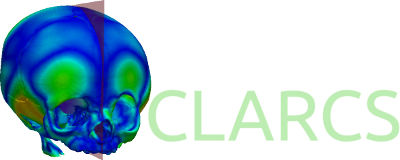Overview |
About CLARCS
CLARCS is a C++ library for surface processing and analysis which has been developed at IRISA (http://www.irisa.fr) since 2007. The library is mainly composed of three basic algorithms allowing :
- (i) the rigid/affine/non-linear registration of two point sets,
- (ii) the computation of the mid-sagittal plane of one point set,
- (iii) the computation of a mean point set from several point sets, and the variability around this mean.
Features
- 3 main methods are available to compute the symmetry plane of a surface: ICP with trimmed estimator, improved EM-ICP, symmetric EM-ICP
- Several rigid and affine registration methods
- Several non linear registration methods
- An improved surface smoothing method
- Statistical analysis of surfaces
Applications
At this time, CLARCS has been successfully used in 2 fields of applications : Medicine and Paleontology.
In medicine, 3 applications have been tested for the moment :
In medicine, 3 applications have been tested for the moment :
- The quantification of skull asymmetries in craniosynostoses
- The quantification of skull asymmetries in deformational plagiocephaly
- Building statistical shape models of deep grey nuclei
Dependencies
CLARCS is mainly based on 4 external libraries :
- The Visualization ToolKit (VTK, http://www.vtk.org) is used for the KdTree research, for surface read/writes methods and for visualization helpers. Thanks to VTK, CLARCS is compatible with various file format (OBJ, VTK, etc)
- Boost (http://www.boost.org) is used for matrix and vector computation.
- Blas and Lapack (http://www.netlib.org) are used for fast matrix computing.
